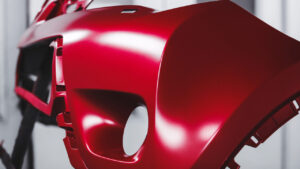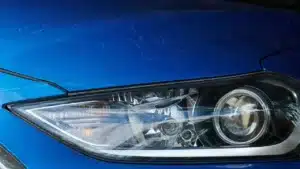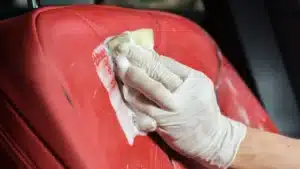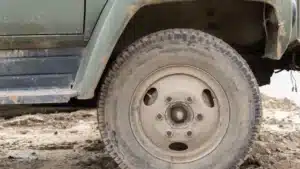Many of today’s vehicles have plastic body parts. If you want to paint these sections of the exterior, you need a different approach. The best spray paint for automotive plastic is different from the most acceptable products for metal components.
Painting plastic car parts also requires different preparation steps. For example, the smooth plastic parts require an adhesion promoter.
Here is a look at the methods for how to spray paint plastic car parts. Read more about how to remove paint from plastic car parts
7 Plastic Car Parts You Can Spray Paint
Here is a look at seven different plastic car parts you can paint.
- Plastic trim pieces
- Door handles
- The back of side mirrors
- Bumpers with plastic covering
- Wheel accents or hubcap covers
- Spoilers, shark-fins, and other aftermarket additions
- mudflaps
You must be careful not to use the methods for painting plastic car parts on metal components.
Materials Needed to Paint Automotive Plastic Parts
The first step in painting plastic car parts is assembling the necessary tools and materials. Here is what you need.
- A cloth, car soap, and a bucket of water
- Painter’s tape and plastic wrap (if you cannot remove the plastic car parts)
- Additional cloth for drying
- fine sandpaper (800-grit or higher)
- Adhesion promoter and primer
- Spray paint
- Protective gear, including a mask, gloves, and eye protection
- (optional) a lacquer finish to promote shining
Once you have assembled these materials, you can start the prep process.
How Do You Prep Plastic for Painting?
The first step in learning how to paint plastic car parts with spray cans or other aerosol products is to prepare the components for painting. Here are the steps.
- If possible, remove the parts from the car. If this is not possible, use painter’s tape and plastic to cover the metal area surrounding the parts. The components you don’t want to paint shouldn’t be exposed at all or there is a risk of paint splatter.
- Wash the area to paint with car soap and rinse it thoroughly. It must be completely dry before the next step. Use a towel, but also give it time to air dry.
- Sand the part with a fine-grit sandpaper. Ultra-fine paper (800-grit or higher) is best.
- After the area is sanded, you need to rinse it a second time before drying with a towel and giving it time to air dry, as well.
- Finally, you will need to cover the target area with an adhesion promoter. You need to allow the coating to dry completely before continuing to the painting steps.
Once you have completed these steps, you can start with the actual paint application.
How to Paint Plastic Car Parts? (Step By Step)
Ideally, you will have chosen the best spray paint for automotive plastic. These paints are specially formulated to stick to plastic parts. The cleaning and sanding processes should help adherence, too.
Here are the steps for how to paint plastic car parts with spray cans.
- First, you will need to wear a mask and eye protection. Most painters choose to wear gloves to avoid having to wash the paint off their hands after the job.
- You need to use a primer first. You will point the primer can at the target parts and spray a steady, even stream to ensure a proper coating. It is best to hold the can about 6 to 7 inches away from the parts when spraying. Closer could cause splashback and further could cause the primer to dissipate in the air before reaching the parts.
- After waiting for the primer to dry, you will add the actual color. You need to shake the spray paint can well before applying. You should spray an even stream of paint, keeping the can at the same distance from the parts as the primer (6 to 7 inches).
- Wait for the first coat to dry. If you need a second coat, you can apply it after the first one is dry. A second coat could be necessary in different situations, such as if you are painting a light color over a dark color (white over brown or gray, for instance). In some cases, a third coat may be necessary.
- Let the paint dry completely. You can leave it in a dry, safe area overnight to ensure it is completely finished before moving on to the optional lacquer step.
- Add a few coats of lacquer to create a shiny finish. This step is optional, but it can give the parts a like-new shine.
The process can be easier if you have certain types of paint.
What Kind of Paint Will Stick to Plastic?
Standard spray paint may flake or peel when applied to plastic. In addition to getting the surface properly prepared, you can use paints that are specially formulated for plastic.
Paint companies like Valspar, Rust-Oleum, and Krylon offer paints specifically made for plastic parts. In general, acrylic enamel paints are the best option for car parts because they adhere to plastic and can stand up to the elements.
Get Started with Your Automotive Plastic Painting Project
Once you have the proper materials and the best spray paint for automotive plastic, you can feel confident that you will get the job done correctly. As long as you follow the proper preparation steps, use products specifically formulated for plastic, and give each coat time to dry, you will be happy with the results.
FAQ:
Will automotive paint stick to plastic?
Automotive paint for metal may not stick to plastic. When you are deciding how to paint automotive plastic, you should look for products especially formulated to paint plastic. Most major paint brands, including Rust-Oleum and Valspar, offer specialized plastic paints.
Can you paint plastic trim on a car?
You can paint plastic trim on a car. However, the process is different from painting metal car parts. You need to follow a different preparation process, use specialized paints formulated for plastic, and cover metal components so they do not get painted during the process.
Can you spray paint plastic car parts?
If you look up how to paint automotive plastic, you will see that almost every article or tutorial advises you to use spray paint. It allows you to create a smooth, even coating. Also, it dries quickly and doesn’t require you to wash brushes or clean up drips that often form with brushes or rollers.
Do I need to prime plastic before painting?
Yes, primer helps the paint adhere to smooth surfaces like plastic. It is especially helpful if the car is going to be exposed to extreme conditions like wet or cold weather, road dust, or wind. You should use a primer specifically formulated to adhere to plastic because it will also help the paint stick to the surface.
Can you use Rust-Oleum spray paint on plastic?
Rust-Oleum produces protective paints that are ideal for use on vehicles and other outdoor applications. Rust-Oleum has a line of paints formulated especially for plastic that will work well for auto parts.
Related Content:




